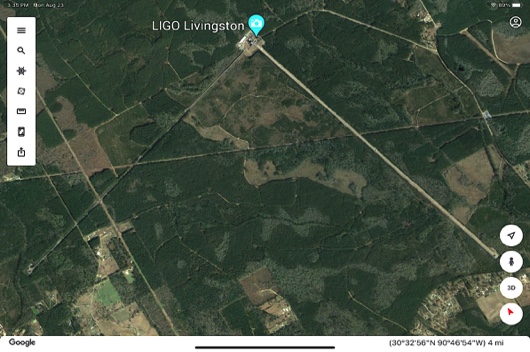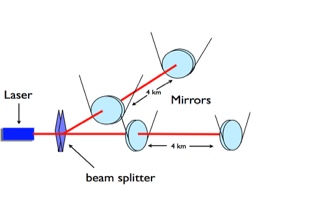Gravitational Waves
This Tuesday (August 11, 2009), I’m on the road once again. During this business trip I will spend a week at the LIGO Laboratory in Hanford Washington. LIGO is a very convenient acronym that stands for Laser Gravitational Wave Observatory. There are two LIGO laboratories, the other one is in Livingston, Louisiana.
What are the LIGO laboratories?
These are actually astronomical observatories. They are separated by approximately 3,000 kilometers (a bit less than 1,900 miles) and they are very different in nature to the standard optical astronomical observatories, those that we associate quickly with telescopes.
TheLIGO observatories are both very similar and they consist in very powerful laser beams that can measure with incredible precision changes in the distance between two suspended mirrors separated by 4 kilometers from each other. They are actually four mirrors, with each pair at the end of two perpendicular arms of equal length (4km).
The picture above is an aerial photograph which partially shows one arm of the interferometer at the LIGO Livingston Lab. The sketch below shows how a laser beam is split and travels through each arm between the suspended mirrors located at the end of each arm.
Einstein’s finished symphony

What follows is a translation from the Spanish text that appeared in my Science blog, the web version of a weekly radio column that run on Argentina National Public Radio Buenos Aires from early 2009 through December 31st, 2010.

Due to the fact that the travel time of the beam between the two mirrors can be measured with incredible precision, very tiny changes in the distance between them can also be detected. And why so much interest in measuring such small changes in the distance?
Gravitational Waves
Gravitational waves are produced by the motion of very compact stellar masses, like colliding black holes, neutron stars or exploding stars. When this massive and compact objects have monster masses but are quite small in size. They are essentially moribund stars who have exhausted all their energy and a mass equivalent to many suns is compacted to a size as small as a city. These masses are each bound to the gravitational field of their companion, and as they dance around each other they drag the fabric of space-time itself with their dance. Space is in some sense like an extremely large three dimensional carpet where we stars, planets and people live. the ripples produced by the dancing of these incredibly compact and massive objects travel on these carpet very long distances. This ripples travel and are perceived like waves, undulations in the fabric of space itself..
We can make an analogy with the waves formed in the oceans by the action of tides and winds. If one wants to measure the amplitude of these waves (which is equivalent to measure how energetic they are) we only need to watch an object go up and down with the swinging of the wave, like a buoy at sea. The stronger the wave, the taller it will be and the higher and lower the buoy will oscillate.
The mirrors in the interferometer behave in many respects in a manner similar to the ocean buoys.
The main difference is that, although the energy typically released by the dancing of these stars is enormous, its waves need to travel distances that are just mind boggling. We expect that the most likely candidates will be so far that the travel time for these waves to reach us in our life times their collision should have occurred hundred of millions of years ago. These means they are so far away, much farther than the confines of our galaxy, that the changes in distance that we measure in the distance between the two mirrors of our interferometer will be so small that we expect them to be smaller than the number that results of dividing one meter by a quintillion (i.e. a decimal point after zero followed by nineteen zeros!). This is a number way much smaller than an atom, actually smaller than a hydrogen atom’s nucleus.
We have not detected gravitational waves yet. They were predicted by Einstein in 1916 as a result of his theory of general relativity, which is the most complete theory of gravitation. Due to the fact that detecting gravitational waves is so different from optical astronomy and it’s actually more similar to listening to the sounds of the universe, I like to compare the waves to a symphony. (I’m not the first one in using this term: there is a book by Martha Bartusiak that is precisely called like the title of this radio column).
Although we have not been able to listen to this symphony yet the sensitivity that our instruments have achieved is a true technological feat. Soon this technological prowess will be improved by an order of magnitude, extending the reach of the volume of the universe that we can listen to about thousand times more. There are clear indications that then we will start to listen to it. It most likely happen with the upgrades ongoing to the LIGO interferometers now. We expect them to be operational by 2016. Stay tuned!
websites with much more information: http://www.ligo.org